How Geography and Climate Shaped the Genomic Diversity of Italian Local Cattle and Sheep Breeds
Abstract
:Simple Summary
Abstract
1. Introduction
2. Materials and Methods
2.1. Available Data
2.2. Sample Collection and SNP Genotypic Data
2.2.1. Bovine Data
2.2.2. Ovine Data
2.3. Climatic Variables
2.4. General Statistical Approach
2.5. Redundancy Analysis
2.6. Specific Statistical Analyses
2.6.1. Climatic Variability
2.6.2. Association of Climate to Geography
2.6.3. Breed Genomic Variability
2.6.4. Association of Genome to Climate and Geography
3. Results and Discussion
3.1. Principal Component Analysis of Climatic Data
3.2. Genomic Diversity of Cattle Breeds
3.2.1. Redundancy Analysis according to Geography in Cattle
3.2.2. Redundancy Analysis according to Climate Conditioned for Geography in Cattle
3.3. Genomic Diversity of Sheep Breeds
3.3.1. Redundancy Analysis According to Geography in Sheep
3.3.2. Redundancy Analysis According to Climate Conditioned for Geography in Sheep
3.4. Cattle and Sheep Genetic Diversity along the Climatic and Geographic Dimensions
4. Conclusions
Supplementary Materials
Author Contributions
Funding
Data Availability Statement
Acknowledgments
Conflicts of Interest
References
- Felius, M.; Beerling, M.L.; Buchanan, D.S.; Theunissen, B.; Koolmees, P.A.; Lenstra, J.A. On the history of cattle genetic resources. Diversity 2014, 6, 705–750. [Google Scholar] [CrossRef]
- Vigne, J.D. Early domestication and farming: What should we know or do for a better understanding? Anthropozoologica 2015, 50, 123–150. [Google Scholar] [CrossRef]
- Fratianni, S.; Acquaotta, F. The climate of Italy. In Landscapes and Landforms of Italy; Springer: Berlin/Heidelberg, Germany, 2017; pp. 29–38. [Google Scholar]
- Ciani, E.; Ciampolini, R.; D’Andrea, M.; Castellana, E.; Cecchi, F.; Incoronato, C.; d’Angelo, F.; Albenzio, M.; Pilla, F.; Matassino, D.; et al. Analysis of genetic variability within and among Italian sheep breeds reveals population stratification and suggests the presence of a phylogeographic gradient. Small Rumin. Res. 2013, 112, 21–27. [Google Scholar] [CrossRef]
- Mastrangelo, S.; Ciani, E.; Ajmone Marsan, P.; Bagnato, A.; Battaglini, L.; Bozzi, R.; Carta, A.; Catillo, G.; Cassandro, M.; Casu, S.; et al. Conservation status and historical relatedness of Italian cattle breeds. Genet. Sel. Evol. 2018, 50, 1–16. [Google Scholar] [CrossRef] [PubMed]
- Cortellari, M.; Barbato, M.; Talenti, A.; Bionda, A.; Carta, A.; Ciampolini, R.; Ciani, E.; Crisà, A.; Frattini, S.; Lasagna, E.; et al. The climatic and genetic heritage of Italian goat breeds with genomic SNP data. Sci. Rep. 2021, 11, 1–12. [Google Scholar] [CrossRef]
- Marino, R.; Atzori, A.S.; D’Andrea, M.; Iovane, G.; Trabalza-Marinucci, M.; Rinaldi, L. Climate change: Production performance, health issues, greenhouse gas emissions and mitigation strategies in sheep and goat farming. Small Rumin. Res. 2016, 135, 50–59. [Google Scholar] [CrossRef]
- Conte, G.; Ciampolini, R.; Cassandro, M.; Lasagna, E.; Calamari, L.; Bernabucci, U.; Abeni, F. Feeding and nutrition management of heat-stressed dairy ruminants. Ital. J. Anim. Sci. 2018, 17, 604–620. [Google Scholar] [CrossRef]
- Rojas-Downing, M.M.; Nejadhashemi, A.P.; Harrigan, T.; Woznicki, S.A. Climate change and livestock: Impacts, adaptation, and mitigation. Clim. Risk Manag. 2017, 16, 145–163. [Google Scholar] [CrossRef]
- Klingenberg, C.P. Phenotypic plasticity, developmental instability, and robustness: The concepts and how they are connected. Front. Ecol. Evol. 2019, 7, 56. [Google Scholar] [CrossRef]
- Rovelli, G.; Ceccobelli, S.; Perini, F.; Demir, E.; Mastrangelo, S.; Conte, G.; Abeni, F.; Marletta, D.; Ciampolini, R.; Cassandro, M.; et al. The genetics of phenotypic plasticity in livestock in the era of climate change: A review. Ital. J. Anim. Sci. 2020, 19, 997–1014. [Google Scholar] [CrossRef]
- Ciani, E.; Crepaldi, P.; Nicoloso, L.; Lasagna, E.; Sarti, F.M.; Moioli, B.; Napolitano, F.; Carta, A.; Usai, G.; D’Andrea, M.; et al. Genome-wide analysis of I talian sheep diversity reveals a strong geographic pattern and cryptic relationships between breeds. Anim. Genet. 2014, 45, 256–266. [Google Scholar] [CrossRef] [PubMed]
- Ben-Jemaa, S.; Senczuk, G.; Ciani, E.; Ciampolini, R.; Catillo, G.; Boussaha, M.; Pilla, F.; Portolano, B.; Mastrangelo, S. Genome-Wide Analysis Reveals Selection Signatures Involved in Meat Traits and Local Adaptation in Semi-Feral Maremmana Cattle. Front. Genet. 2021, 12, 675569. [Google Scholar] [CrossRef] [PubMed]
- Mastrangelo, S.; Tolone, M.; Ben Jemaa, S.; Sottile, G.; Di Gerlando, R.; Cortés, O.; Senczuk, G.; Portolano, B.; Pilla, F.; Ciani, E. Refining the genetic structure and relationships of European cattle breeds through meta-analysis of worldwide genomic SNP data, focusing on Italian cattle. Sci. Rep. 2020, 10, 1–13. [Google Scholar]
- Senczuk, G.; Mastrangelo, S.; Ciani, E.; Battaglini, L.; Cendron, F.; Ciampolini, R.; Crepaldi, P.; Mantovani, R.; Bongioni, G.; Pagnacco, G.; et al. The genetic heritage of Alpine local cattle breeds using genomic SNP data. Genet. Sel. Evol. 2020, 52, 1–12. [Google Scholar] [CrossRef] [PubMed]
- Dimauro, C.; Nicoloso, L.; Cellesi, M.; Macciotta, N.; Ciani, E.; Moioli, B.; Pilla, F.; Crepaldi, P. Selection of discriminant SNP markers for breed and geographic assignment of Italian sheep. Small Rumin. Res. 2015, 128, 27–33. [Google Scholar] [CrossRef]
- Moioli, B.; Pilla, F.; Ciani, E. Signatures of selection identify loci associated with fat tail in sheep. J. Anim. Sci. 2015, 93, 4660–4669. [Google Scholar] [CrossRef] [PubMed]
- Mastrangelo, S.; Ciani, E.; Sardina, M.; Sottile, G.; Pilla, F.; Portolano, B.; Consortium, B.O.I. Runs of homozygosity reveal genome-wide autozygosity in Italian sheep breeds. Anim. Genet. 2018, 49, 71–81. [Google Scholar] [CrossRef] [PubMed]
- Cavalli-Sforza, L.L. Population structure and human evolution. Proc. R. Soc. Lond. Ser. B. Biol. Sci. 1966, 164, 362–379. [Google Scholar]
- Laloë, D.; Moazami-Goudarzi, K.; Lenstra, J.A.; Marsan, P.A.; Azor, P.; Baumung, R.; Bradley, D.G.; Bruford, M.W.; Cañón, J.; Dolf, G. Spatial trends of genetic variation of domestic ruminants in europe. Diversity 2010, 2, 932–945. [Google Scholar] [CrossRef]
- Gautier, M.; Laloë, D.; Moazami-Goudarzi, K. Insights into the genetic history of French cattle from dense SNP data on 47 worldwide breeds. PLoS ONE 2010, 5, e13038. [Google Scholar] [CrossRef]
- Laloë, D.; Gautier, M. On the Genetic Interpretation of Between-Group PCA on SNP Data. HAL—Sci. Ouverte 2012, hal-006612, 1–23. [Google Scholar]
- Jombart, T.; Devillard, S.; Dufour, A.B.; Pontier, D. Revealing cryptic spatial patterns in genetic variability by a new multivariate method. Heredity 2008, 101, 92–103. [Google Scholar] [CrossRef] [PubMed]
- Rao, C.R. The use and interpretation of principal component analysis in applied research. Sankhyā Indian J. Stat. Ser. A 1964, 26, 329–358. [Google Scholar]
- Legendre, P.; Legendre, L. Numerical Ecology; Elsevier Science Publishers: Amsterdam, The Netherlands, 2012. [Google Scholar]
- Lasky, J.R.; Des Marais, D.L.; McKAY, J.; Richards, J.H.; Juenger, T.E.; Keitt, T.H. Characterizing genomic variation of Arabidopsis thaliana: The roles of geography and climate. Mol. Ecol. 2012, 21, 5512–5529. [Google Scholar] [CrossRef] [PubMed]
- Capblancq, T.; Forester, B.R. Redundancy analysis: A Swiss Army Knife for landscape genomics. Methods Ecol. Evol. 2021, 12, 2298–2309. [Google Scholar] [CrossRef]
- Kriticos, D.J.; Webber, B.L.; Leriche, A.; Ota, N.; Macadam, I.; Bathols, J.; Scott, J.K. CliMond: Global high-resolution historical and future scenario climate surfaces for bioclimatic modelling: CliMond: Climate surfaces for bioclimatic modelling. Methods Ecol. Evol. 2012, 3, 53–64. [Google Scholar] [CrossRef]
- Francesco, F.G.; Florent, M.; Wilfried, T. Global determinants of zoogeographical boundaries. Nat. Ecol. Evol. 2017, 1, 0089. [Google Scholar]
- R Core Team. R: A Language and Environment for Statistical Computing; R Foundation for Statistical Computing: Vienna, Austria, 2022. [Google Scholar]
- Legendre, P.; Oksanen, J.; ter Braak, C.J. Testing the significance of canonical axes in redundancy analysis. Methods Ecol. Evol. 2011, 2, 269–277. [Google Scholar] [CrossRef]
- Anderson, M.J. Permutational multivariate analysis of variance (PERMANOVA). In Wiley StatsRef: Statistics Reference Online; John Wiley & Sons, Ltd.: Hoboken, NJ, USA, 2014; pp. 1–15. [Google Scholar]
- Thioulouse, J.; Renaud, S.; Dufour, A.B.; Dray, S. Overcoming the spurious groups problem in between-group PCA. Evol. Biol. 2021, 48, 458–471. [Google Scholar] [CrossRef]
- Oksanen, J.; Simpson, G.L.; Blanchet, F.G.; Kindt, R.; Legendre, P.; Minchin, P.R.; O’Hara, R.; Solymos, P.; Stevens, M.H.H.; Szoecs, E.; et al. vegan: Community Ecology Package, R Package Version 2.6-2; Vienna, Austria, 2022.
- Thioulouse, J.; Dray, S.; Dufour, A.B.; Siberchicot, A.; Jombart, T.; Pavoine, S. Multivariate Analysis of Ecological Data with ade4; Springer: Berlin/Heidelberg, Germany, 2018. [Google Scholar] [CrossRef]
- Martin, A.P. Phylogenetic approaches for describing and comparing the diversity of microbial communities. Appl. Environ. Microbiol. 2002, 68, 3673–3682. [Google Scholar] [CrossRef] [PubMed]
- Jombart, T.; Pontier, D.; Dufour, A.B. Genetic markers in the playground of multivariate analysis. Heredity 2009, 102, 330–341. [Google Scholar] [CrossRef]
- Senczuk, G.; Mastrangelo, S.; Ajmone-Marsan, P.; Becskei, Z.; Colangelo, P.; Colli, L.; Ferretti, L.; Karsli, T.; Lancioni, H.; Lasagna, E.; et al. On the origin and diversification of Podolian cattle breeds: Testing scenarios of European colonization using genome-wide SNP data. Genet. Sel. Evol. 2021, 53, 1–16. [Google Scholar] [CrossRef] [PubMed]
- Lawrence, E.R.; Fraser, D.J. Latitudinal biodiversity gradients at three levels: Linking species richness, population richness and genetic diversity. Glob. Ecol. Biogeogr. 2020, 29, 770–788. [Google Scholar] [CrossRef]
- Mastrangelo, S.; Portolano, B.; Di Gerlando, R.; Ciampolini, R.; Tolone, M.; Sardina, M.; The International Sheep Genomics Consortium. Genome-wide analysis in endangered populations: A case study in Barbaresca sheep. Animal 2017, 11, 1107–1116. [Google Scholar] [CrossRef] [PubMed]
- Persichilli, C.; Senczuk, G.; Pasqualino, L.; Anzalone, D.A.; Negrini, R.; Ajmone Marsan, P.; Colli, L.; Pilla, F.; Mastrangelo, S. Genome-wide diversity of Pagliarola sheep residual population and its conservation implication. Ital. J. Anim. Sci. 2021, 20, 1695–1705. [Google Scholar] [CrossRef]
- Mastrangelo, S.; Bahbahani, H.; Moioli, B.; Ahbara, A.; Al Abri, M.; Almathen, F.; Da Silva, A.; Belabdi, I.; Portolano, B.; Mwacharo, J.M.; et al. Novel and known signals of selection for fat deposition in domestic sheep breeds from Africa and Eurasia. PLoS ONE 2019, 14, e0209632. [Google Scholar] [CrossRef] [PubMed]
- Longinelli, A.; Selmo, E. Isotopic composition of precipitation in Italy: A first overall map. J. Hydrol. 2003, 270, 75–88. [Google Scholar]
- Decker, J.E.; McKay, S.D.; Rolf, M.M.; Kim, J.; Molina Alcalá, A.; Sonstegard, T.S.; Hanotte, O.; Götherström, A.; Seabury, C.M.; Praharani, L.; et al. Worldwide patterns of ancestry, divergence, and admixture in domesticated cattle. PLoS Genet. 2014, 10, e1004254. [Google Scholar] [CrossRef] [PubMed]
- Ciani, E.; Mastrangelo, S.; Da Silva, A.; Marroni, F.; Ferenčaković, M.; Ajmone-Marsan, P.; Baird, H.; Barbato, M.; Colli, L.; Delvento, C. On the origin of European sheep as revealed by the diversity of the Balkan breeds and by optimizing population-genetic analysis tools. Genet. Sel. Evol. 2020, 52, 1–14. [Google Scholar] [CrossRef] [PubMed]
- Deng, J.; Xie, X.L.; Wang, D.F.; Zhao, C.; Lv, F.H.; Li, X.; Yang, J.; Yu, J.L.; Shen, M.; Gao, L.; et al. Paternal origins and migratory episodes of domestic sheep. Curr. Biol. 2020, 30, 4085–4095. [Google Scholar] [CrossRef] [PubMed]
- Alberto, F.J.; Boyer, F.; Orozco-terWengel, P.; Streeter, I.; Servin, B.; de Villemereuil, P.; Benjelloun, B.; Librado, P.; Biscarini, F.; Colli, L.; et al. Convergent genomic signatures of domestication in sheep and goats. Nat. Commun. 2018, 9, 1–9. [Google Scholar] [CrossRef] [PubMed]
- Joy, A.; Dunshea, F.R.; Leury, B.J.; Clarke, I.J.; DiGiacomo, K.; Chauhan, S.S. Resilience of small ruminants to climate change and increased environmental temperature: A Review. Animals 2020, 10, 867. [Google Scholar] [CrossRef] [PubMed]
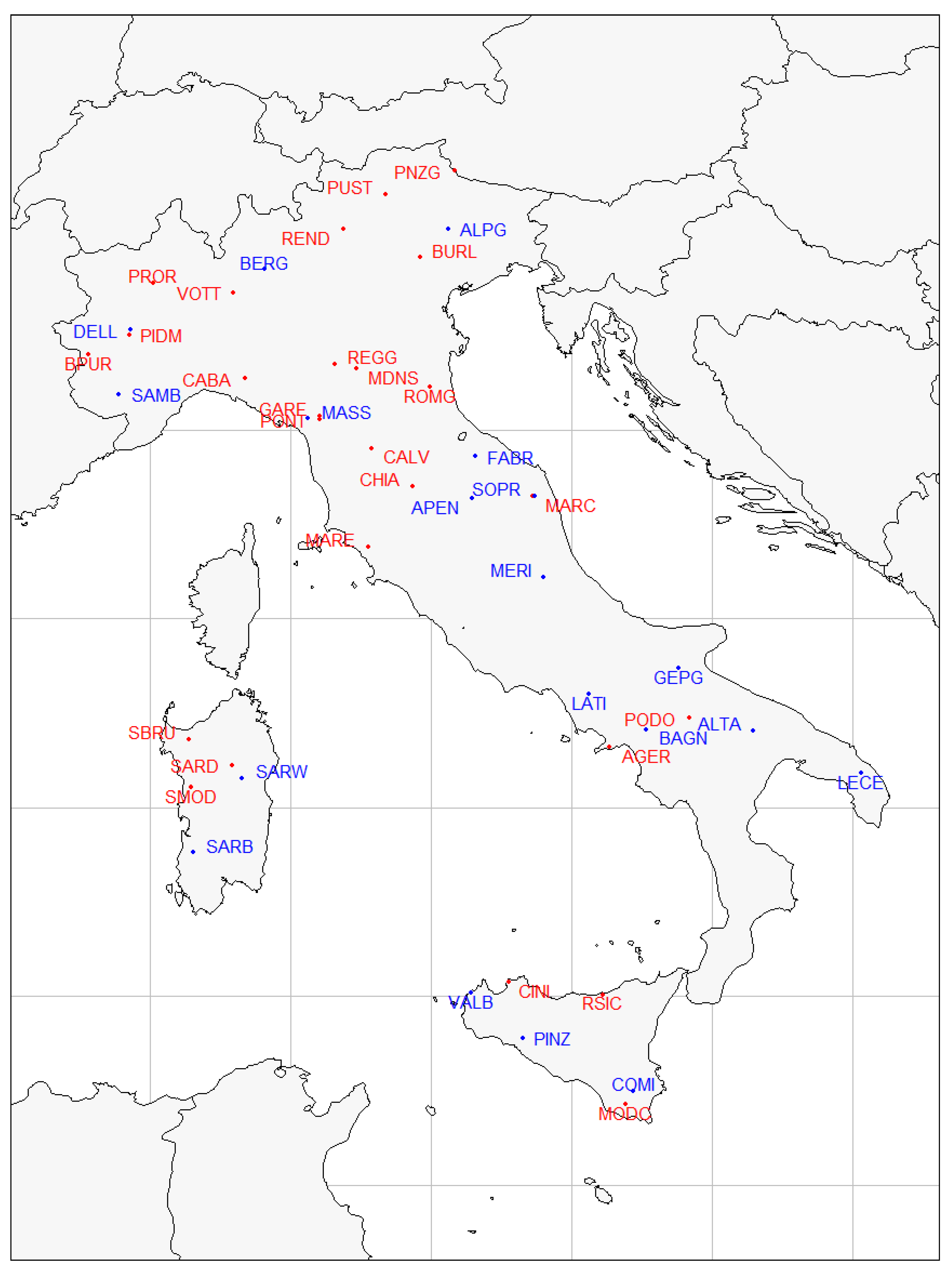
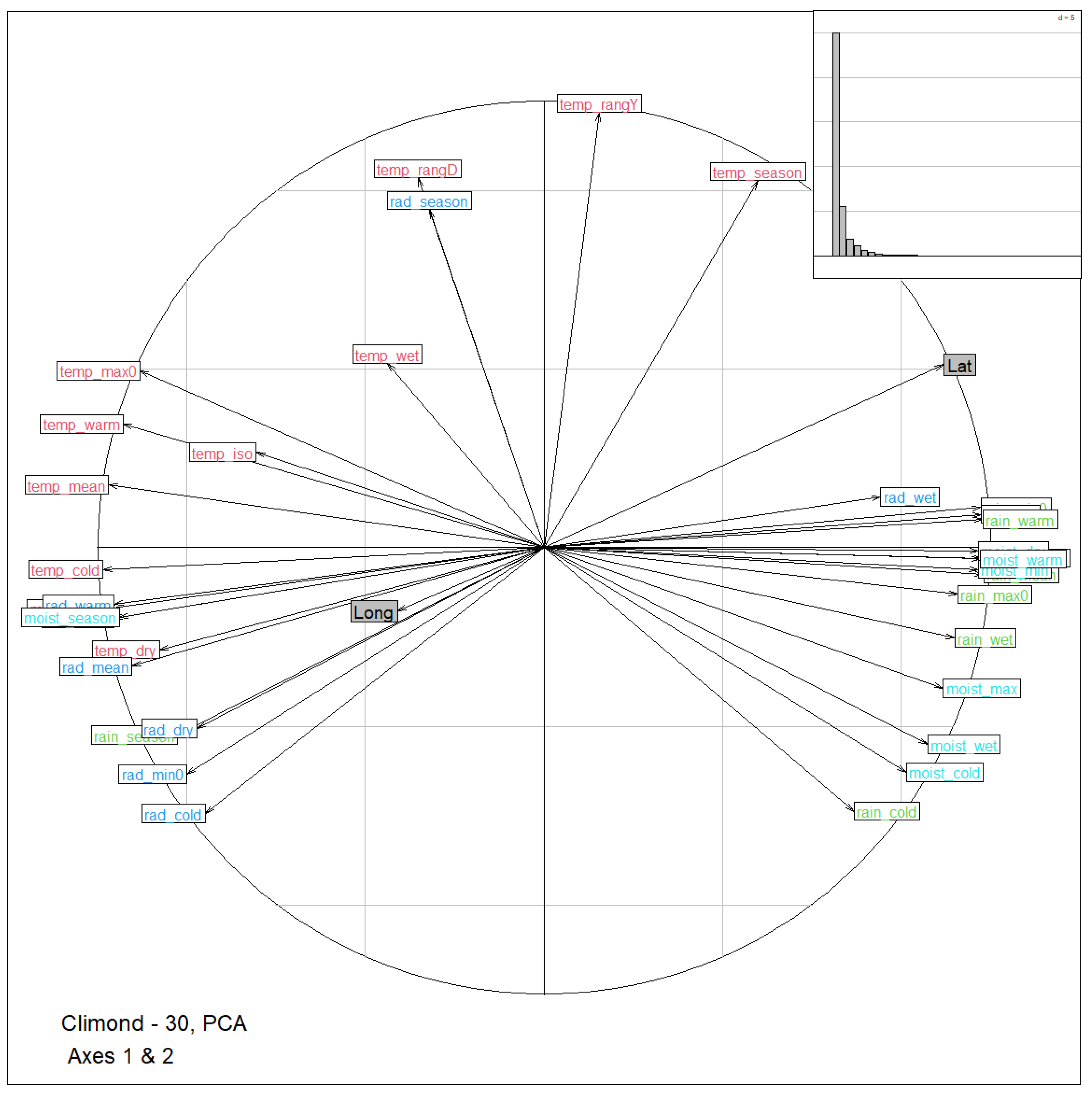
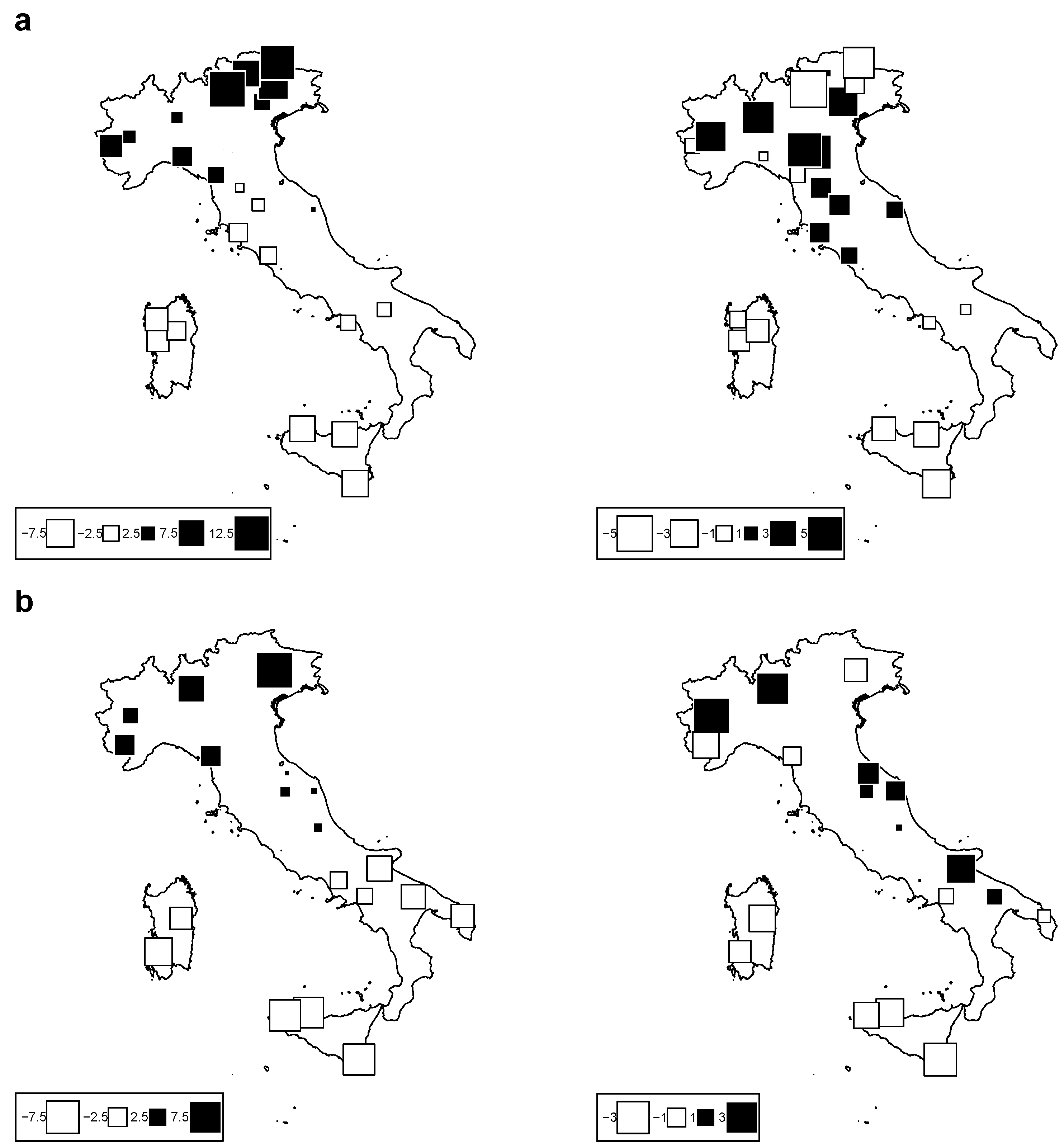
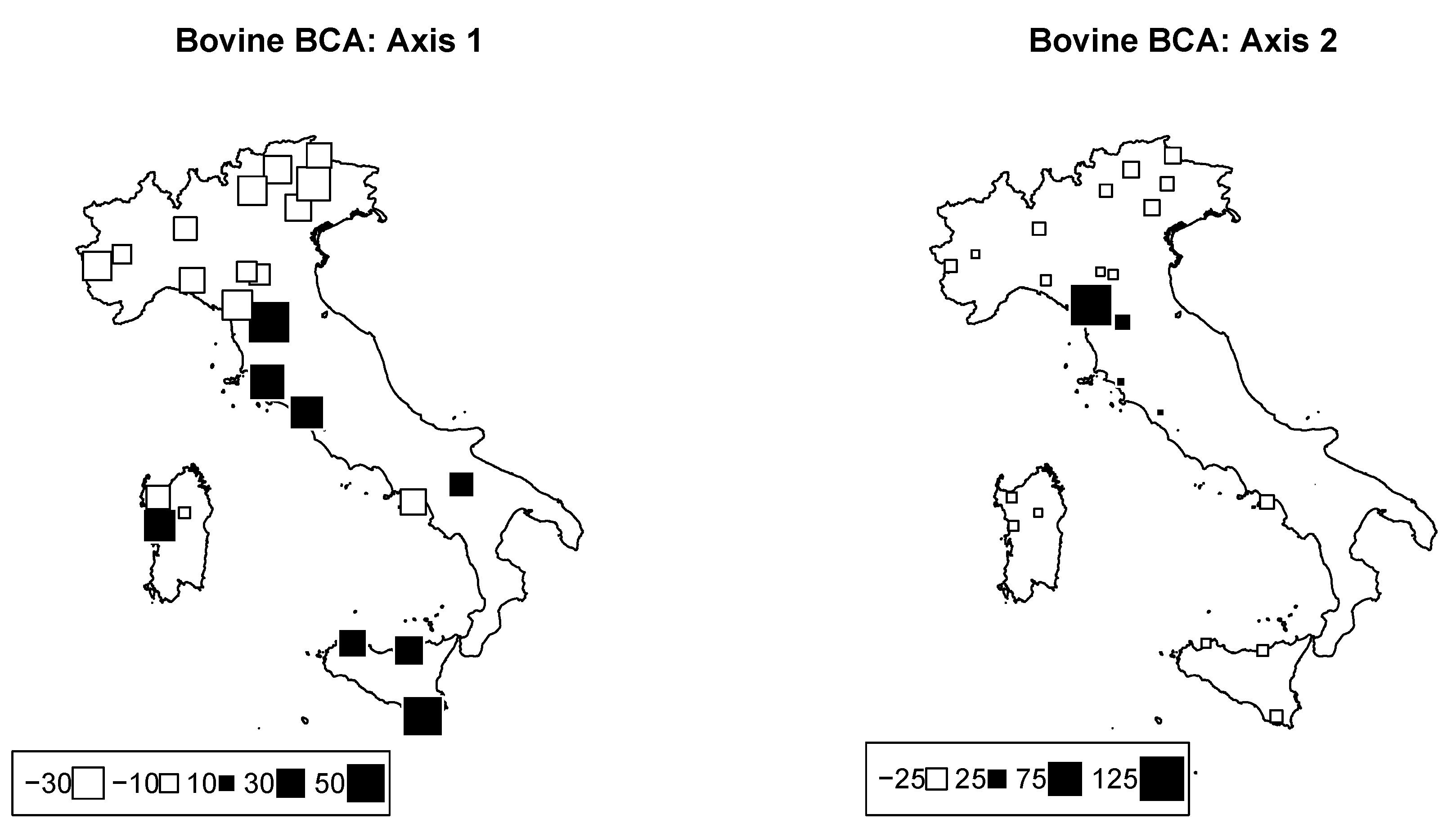
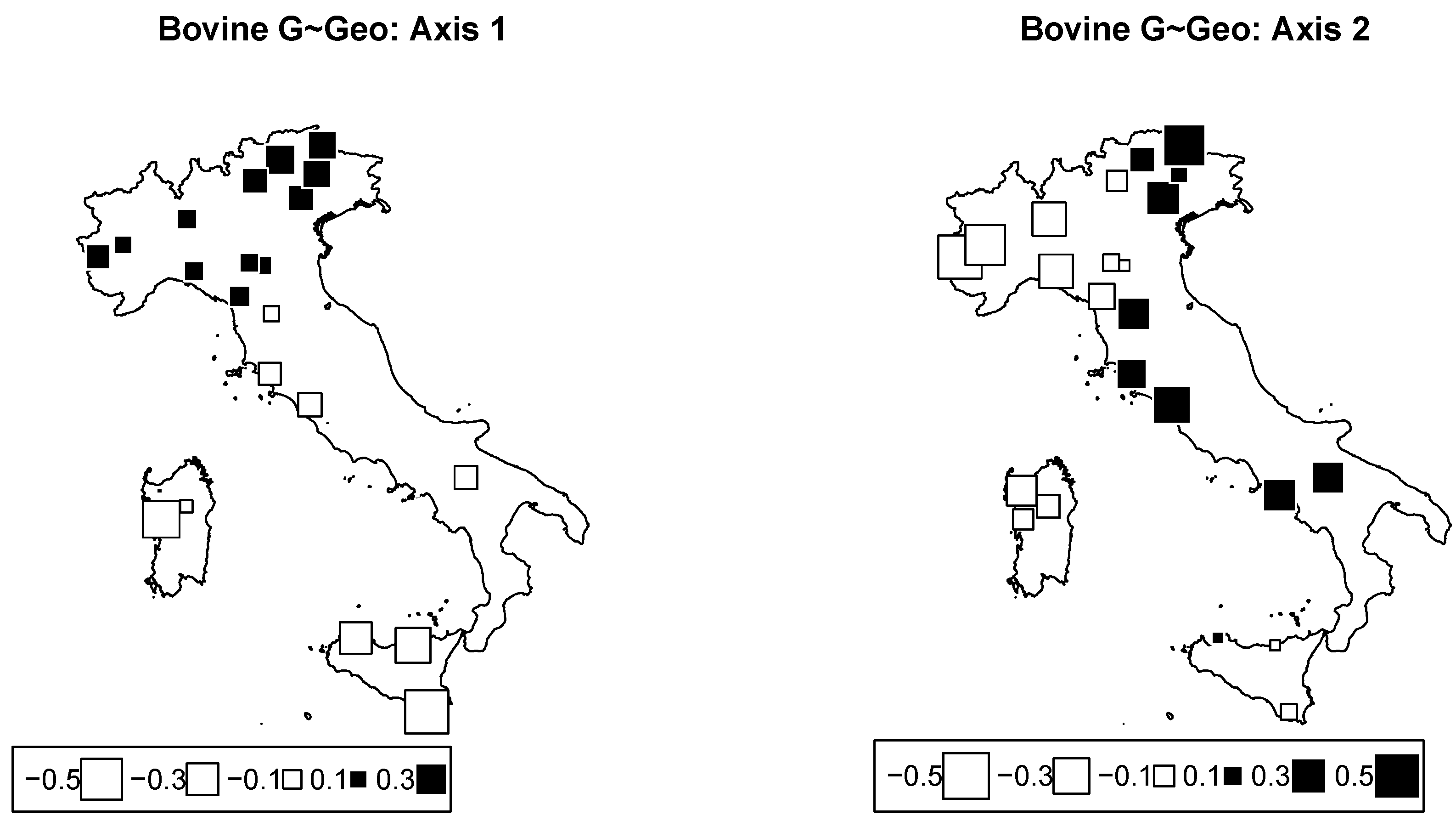


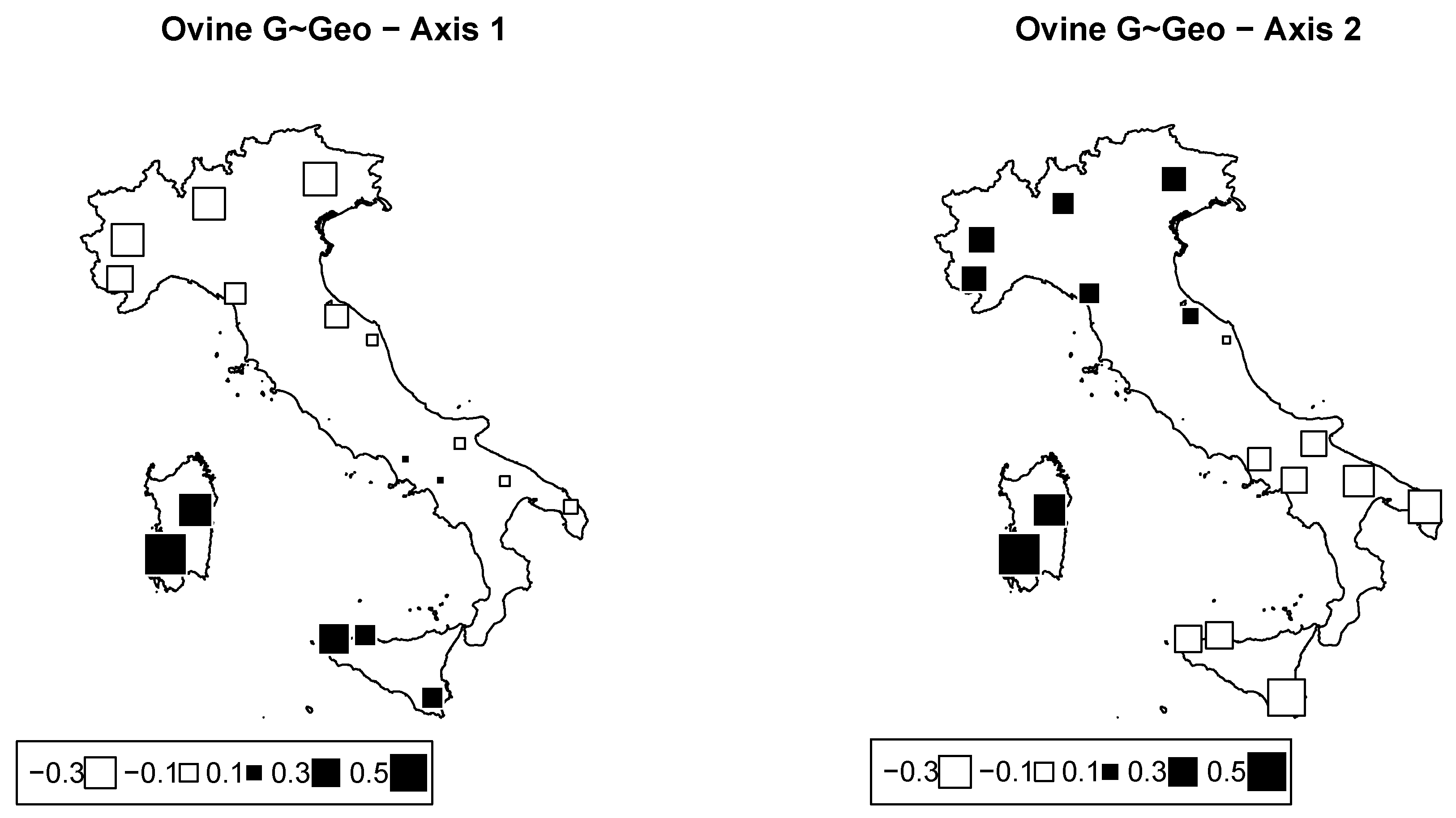
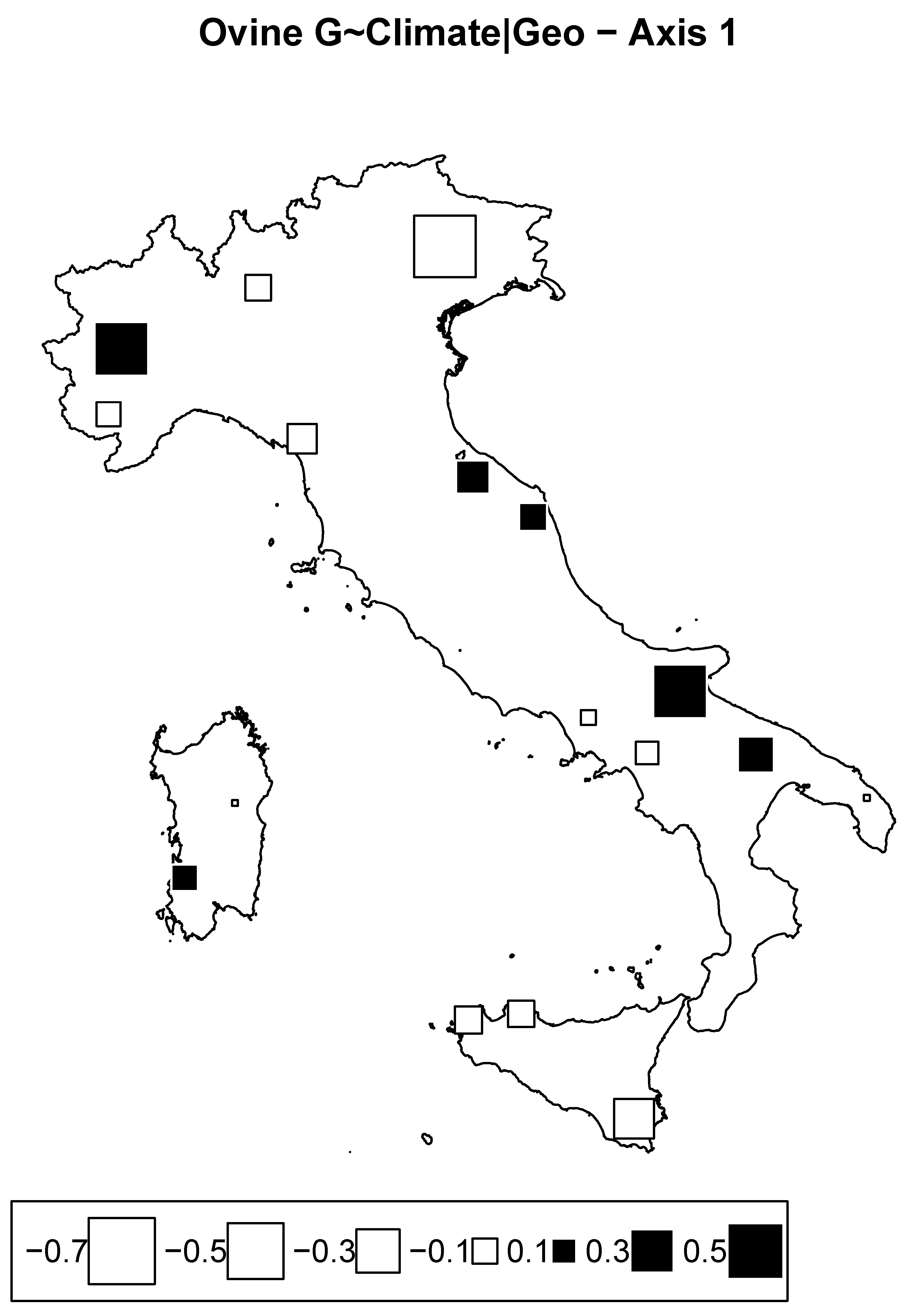
| CATTLE | SHEEP | ||
|---|---|---|---|
| Agerolese | AGER | Alpagota | ALPG |
| Bará-pustertaler | BPUR | Altamurana | ALTA |
| Burlina | BURL | Appenninica | APEN |
| Cabannina | CABA | Bagnolese | BAGN |
| Calvana | CALV | Bergamasca | BERG |
| Chianina | CHIA | Comisana | COMI |
| Cinisara | CINI | Delle Langhe | DELL |
| Garfagnina | GARF | Fabrianese | FABR |
| Marchigiana | MARC | Gentile di Puglia | GEPG |
| Maremmana | MARE | Laticauda | LATI |
| Modenese | MDNS | Leccese | LECE |
| Modicana | MODC | Massese | MASS |
| Pezzata Rossa d’Oropa | PROR | Merinizzata | MERI |
| Piedmontese | PIDM | Pinzirita | PINZ |
| Pinzgau | PNZG | Sambucana | SAMB |
| Podolica | PODO | Sardinian Ancestral Black | SARB |
| Pontremolese | PONT | Sardinian White | SARW |
| Pustertaler | PUST | Sopravissana | SOPR |
| Reggiana | REGG | Valle del Belice | VALB |
| Rendena | REND | ||
| Romagnola | ROMG | ||
| Rossa siciliana | RSIC | ||
| Sarda | SARD | ||
| Sardo-Bruna | SBRU | ||
| Sardo-Modicana | SMOD | ||
| Varzese-ottonese | VOTT |
| Source | d.f. | Variance | F | Pr (>F) |
|---|---|---|---|---|
| Latitude | 1 | 20.48 | 62.36 | 0.001 |
| Longitude | 1 | 0.23 | 0.71 | 0.473 |
| Latitude:longitude | 1 | 0.83 | 2.53 | 0.084 |
| Residual | 46 | 13.46 |
| Source | Inertia | % Inertia |
|---|---|---|
| Latitude | 509.92 | 7.5 |
| Longitude | 255.51 | 3.7 |
| Latitude:longitude | 235.25 | 3.5 |
| Total | 6818.52 | 100 |
| Source | Inertia | % Inertia |
|---|---|---|
| Latitude | 581.94 | 10.35 |
| Longitude | 453.56 | 8.07 |
| Latitude:longitude | 443.61 | 7.89 |
| Total | 5621.12 | 100 |
| RDA Component | Cattle (Fst = 0.177) | Sheep (Fst = 0.144) | |||
|---|---|---|---|---|---|
| % Inertia | p-Value | % | p-Value | ||
| Geog (Lat*Long) | RDA1 | 7.5 | 0.03 | 11.5 | < 0.01 |
| RDA2 | 4.6 | 0.66 | 8.1 | 0.02 | |
| RDA3 | 2.6 | 0.97 | 6.7 | 0.14 | |
| Total | 14.7 | 26.3 | |||
| Clim|Geog | RDA1 | 6 | 0.09 | 7.5 | 0.18 |
| RDA2 | 4.1 | 0.56 | 4.8 | 0.74 | |
| Total | 10.1 | 12.3 | |||
Publisher’s Note: MDPI stays neutral with regard to jurisdictional claims in published maps and institutional affiliations. |
© 2022 by the authors. Licensee MDPI, Basel, Switzerland. This article is an open access article distributed under the terms and conditions of the Creative Commons Attribution (CC BY) license (https://creativecommons.org/licenses/by/4.0/).
Share and Cite
Senczuk, G.; Criscione, A.; Mastrangelo, S.; Biscarini, F.; Marletta, D.; Pilla, F.; Laloë, D.; Ciampolini, R. How Geography and Climate Shaped the Genomic Diversity of Italian Local Cattle and Sheep Breeds. Animals 2022, 12, 2198. https://doi.org/10.3390/ani12172198
Senczuk G, Criscione A, Mastrangelo S, Biscarini F, Marletta D, Pilla F, Laloë D, Ciampolini R. How Geography and Climate Shaped the Genomic Diversity of Italian Local Cattle and Sheep Breeds. Animals. 2022; 12(17):2198. https://doi.org/10.3390/ani12172198
Chicago/Turabian StyleSenczuk, Gabriele, Andrea Criscione, Salvatore Mastrangelo, Filippo Biscarini, Donata Marletta, Fabio Pilla, Denis Laloë, and Roberta Ciampolini. 2022. "How Geography and Climate Shaped the Genomic Diversity of Italian Local Cattle and Sheep Breeds" Animals 12, no. 17: 2198. https://doi.org/10.3390/ani12172198
APA StyleSenczuk, G., Criscione, A., Mastrangelo, S., Biscarini, F., Marletta, D., Pilla, F., Laloë, D., & Ciampolini, R. (2022). How Geography and Climate Shaped the Genomic Diversity of Italian Local Cattle and Sheep Breeds. Animals, 12(17), 2198. https://doi.org/10.3390/ani12172198






